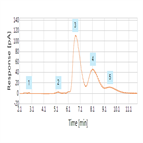Find methods for your needs
Refine by Feature
Displaying 1-5 of 35 results for Tag: Surfactant
AN1080: Automated Solid-Phase Extraction of Linear Alkylbenzene Sulfonatein Wastewater Using a Weak Anion-Exchange Cartridge Followed by HPLC with UV Detection
Instrument Type: HPLCSurfactants are the major active ingredients of laundry detergents. Anionic surfactants account for 60% of surfactant used in the U. S. Linear alkylbenzene sulfonate (LAS) is an anionic surfactant. It is a mixture of closely-related isomers and homologues, each containing an aromatic ring sulfonated at the para position and attached to a linear alkyl chain. This application provides a complete workflow method for the extraction and analysis of LAS is waste water samples.
Characterization of of Pluronic F127 Surfactant by HPLC-CAD
Instrument Type: HPLC-CADPluronic F127, or Poloxamer 407, is a non-ionic, polyol surfactant. Due to the variety of different structures contained within this complex product, a characterization method is described to determine the relative amounts of the different components, which may vary from lot-to-lot.
Characterization of Triton X-100 Surfactant by HPLC-CAD
Instrument Type: HPLC-CADTriton X-100, is a polyethylene oxide-based, non-ionic surfactant. Due to the variety of different, polymeric chain-lengths contained within this complex product, a characterization method is described to determine the relative amounts of the different components, which may vary from lot-to-lot.
Characterization of Brij 35 Surfactant by HPLC-CAD
Instrument Type: HPLC-CADBrij 35, is a polyglycol ether, non-ionic surfactant. Due to the variety of different structures contained within this complex product, a characterization method is described to determine the relative amounts of the different components, which may vary from lot-to-lot.
Characterization of of Tween 20 Surfactant by HPLC-CAD
Instrument Type: HPLC-CADTween 20, or polysorbate 20, is a polymeric, non-ionic surfactant. Due to the variety of different structures contained within this complex product, a characterization method is described to determine the relative amounts of the different components, which may vary from lot-to-lot.





